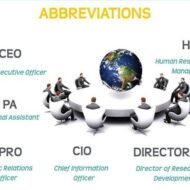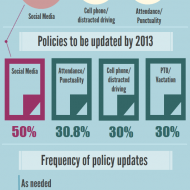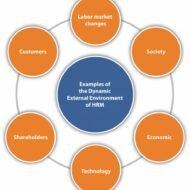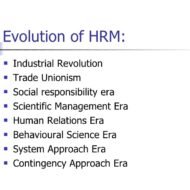Posted by Managementguru in Quiz Corner
on Aug 2nd, 2015 | 0 comments

Acronyms are inevitable components of business life and if you are not familiar with some of the important terms, life can become difficult. Try to unveil these 30 Business Acronyms Related to HR, Finance and Accounting: BKPR CAO SHRM CIPD CTO HCM HPWS CIO CPA BGT COGS EPS LC P&L ROA ROE ROI CIMS DRIFT B2B B2C CTC USP PR INC. IPO GDP EBITD ESO GASS Find the answers below the pic: 1. Book-Keeper 2. Chief Accounting Officer 3. Strategic Human Resource Management 4. Chartered Institute of Personnel and Development 5. Chief Technology Officer 6. High Commitment Management 7. High Performance Work System 8. Chief Information Officer 9. Certified Public Accountant 10. Budget 11. Cost of Goods Sold 12. Earnings Per Share 13. Letter of Credit 14. Profit and Loss 15. Return on Assets 16. Return on Equity 17. Return on Investment 18. Certified Investment Management Specialist 19. Do it Right the First Time 20. Business to Business 21. Business to Consumer 22. Cost to Company 23. Unique Selling Point 24. Public Relations 25. Incorporated 26. Initial Public Offering 27. Gross Domestic Product 28. Earnings Before Interest, Tax and Depreciation 29. Employee Stock Option 30. Generally Accepted Accounting Standards...

Posted by Managementguru in E Sale Point
on Jul 17th, 2014 | 0 comments

I thought it would be helpful to create resource pages on some of the wonderful ‘Online Courses’ available. I recommend bookmarking these pages for your reference and convenience. Enjoy! Since our niche pertains to MANAGEMENT & BUSINESS ADMINISTRATION, let me start with a list of courses on Human Resources, the indispensable organizational factor. Learn how to recruit, hire, train and manage Human Capital. Human Resource Outsourcing ( HRO) has become necessary TO NOT ONLY HIRE BEST TALENT but also to RETAIN THEM. Human Resource Management Courses Let me first list some courses on HUMAN RESOURCE CERIFICATE COURSES 👈 Follow this link These courses include, PMP certification exam prep Payroll management Vendor relations Scrum master certification Employment regulations and programs These courses give you the ease of learning from the comfort of your home at very reasonable prices and also give you an opportunity for passive income by publishing video lectures on Udemy. If you happen to be very successful, this platform might become your main source of income, since people are always hungry for more information and knowledge. Don’t Miss Out On This Course HR Analytics using MS Excel for Human Resource Management Use Excel for HR Analytics, calculate HR metrics, build HR dashboards & ML models for Human Resource & People Analytics To Choose from over 210,000 online video courses with new additions published every month 👈 Follow this link Hope you enjoyed this post, and come back with your valuable feedback if you were benefited by enrolling in any one of these courses. Online learning has become the ‘ORDER OF THE DAY‘ and lot of universities and educational institutions are digitizing their teaching approach and if you happen to be an expert in your niche, ‘YOU ARE MOST WANTED‘. Disclosure: Please note that some are affiliate links, and at no additional cost to you, I will earn a commission if you decide to make a purchase. Please understand that I have experience with all of these companies, and I recommend them because they are helpful and useful, not because of the small commissions I make if you decide to buy...

Posted by Managementguru in Business Management, Decision Making, Human Resource, Organisational behaviour, Principles of Management
on Apr 19th, 2014 | 0 comments

Business Policies – Framing and Execution Business policies are the keystone in the arch of management and the life-blood for the successful functioning of business, because without well-laid down policies, there cannot be lasting improvements in the economic condition of the firm and labor-management relations. A policy is a positive declaration and a command to its followers. It translates the goals of an organization into selected routes and provides the general guidelines that prescribe and proscribe programmes, which in turn, dictate practices and procedure. Attainment of Objectives: Buisness policies are general statement of principles for the attainment of objectives which serve as a guide to action for the executives at different levels of management. They pave a broad way in which the sub-ordinates tread along towards accomplishing their objectives. Hierarchy: For each set of objectives at each level, there is a corresponding set of policies. The Board of Directors determine the basic overall corporate policiesThe top management decides on the executive corporate policiesManagers decide on the departments / divisional policiesMiddle managers handle the sectional policies Consistent Decisions contributing to the Objectives: The policies delimit the area within which a decision has to be made; however, they do allow some discretion on the part of the man on the firing line, otherwise, they would be mere rules. At the same time too much of discretion in policy matters may prove harmful to the accomplishment of organizational objectives and hence it is generally within limits. Mutual Application: Policies in general are meant for mutual application by sub ordinates. They are fabricated to suit a specific situation in which they are applied, for they cannot apply themselves. Unified Structure: Policies tend to predefine issues, avoid repeated analysis and give a unified structure to other types of plans, thus permitting managers to delegate authority while maintaining control. Policies for all Functional Areas: In a well-structured and managed organization, policies are framed for all functional levels of management. Corporate planningMarketingResearch and DevelopmentEngineeringManufacturingInventoryPurchasePhysical DistributionAccountingFinanceCostingAdvertisingPersonal SellingSpecial Promotion, are some areas that require clear-cut policies. Clear-Cut Guidelines: Policies serve an extremely useful purpose in that they avoid confusion and provide clear-cut guidelines. This enables the business to be carried on smoothly and often without break. They lead to better and maximum utilization of resources, human, financial and physical, by adhering to actions for...

Posted by Managementguru in Business Management, Human Resource, Organisational behaviour, Principles of Management
on Mar 20th, 2014 | 0 comments

Changing Trends and Challenges in HRM The very conception of Human resource management has changed tremendously in the recent past as it has taken a new form and shape that embraces each and every activity of the organization, as every action requires human intervention. Human resource has become the most important of all the resources from the point, where it was merely one of the many resources. What has caused this great transformation? What has made firms recognise that manpower is the most important of all resources to the extent of including human resource in their accounting as assets! Evolution of HRM: A thorough analysis of the evolution of human resource management clearly indicates the exceptional quality of manpower, especially managers to tackle the very many challenges that come on their way. A manager who was merely a reporter to the top level management has now become indispensable. The laborers whether skilled or unskilled cannot be treated the way they were treated earlier, as the introduction of many labor laws support their cause. The legal framework guides the organization in terms of pay scale, bonus and increments and supports the workers in their welfare, security and safety. Globalization, Privatization and Liberalization: With the initiation of globalization, privatization and liberalization the firms are exposed to more competition and the managers have to put their think tanks to the best use in order to sustain and succeed in the market. People from various background work together in a multinational firm; their language, dress code, food habits, style of working and adaptability are quite different from one another. A human resource manager must go for a “culture” that is unique to the organization. He has to be proactive in order to safeguard the employees from a “culture shock”, by training them sufficiently before induction. Human behavior: Management of human resources by itself is complex and it needs people with special skills. The unpredictable nature of human behavior makes the job more difficult. In the task of managing the emotions and behavior of his employees, a manager must not lose his composure at any point of time for which he has to be a balanced personality. How many of us are gifted with a balanced state of mind and especially in a crisis situation many of us scream our lungs out and blame others for our own faults. Employee Motivation: Motivating the employees to do the job and steer them in the right direction is a Himalayan task for most of the managers. For this they have to adopt a participative style of leadership that will make the employee come closer to them in terms of trust and openness and also it enhances the productivity by improving the efficiency. A relaxed mind is more efficient than one with tight cords. It thinks and acts freely and gives its best. Now a days employees are more educated and informative, so you cannot take them for granted. They are aware of their rights and privileges regarding their jobs and work environment and managers need to handle them very cautiously and intelligently when it comes to satisfying their needs, sentiments and attitude. Handling a large number of employees, allotment of employees to shifts, managing the turnover and keeping the morale high are some of the challenges that the management has to face up to. Achieving the Desired Results: The biggest challenge of any modern manager would be to show results by managing his team. Achieving targets in the specified time is a herculean task; also making people working for the firm realize and understand that unless and until their products and services are of international standards and customer satisfying,...

Posted by Managementguru in Human Resource, Labor Management, Organisational behaviour, Principles of Management, Training & Development
on Mar 18th, 2014 | 0 comments

Evolution and Growth of Human Resource Management It is very interesting to trace out the evolution and growth of Human Resource Management. People – The Principal Resource The principal resource of any organization is people and managing people is the most important and challenging aspect of an organization. What we call human resource management today, dates back to 1800 b.c.,which is evident from the inscriptions of Babylonian code of Hammurabi and Kautilya’s Arthasashtra, which explains in detail the importance of selection, incentives, performance evaluation, quality of a manager and wage rates. So,we understand that the concept of managing people has existed even in the previous eras through ancient literature and philosophy. India, China and Greece have been the origin points of human resource management concepts. Evolution of Human Resource Management Industrial Revolution Till, 1930’s, there was no such department called “personnel management” that was considered necessary to cater to the needs and welfare of the labor society. The factory manager was acting as a link between the workers and the management, and most of the time he had to comply with the rules of the management to satisfy them, even if it were against the welfare of the workers. Also proper attention was not given to areas like, worker safety, security and living conditions. Industrial revolution saw mass exodus of workers to urban areas in search of jobs. Need for Employment Department Application of science and technology in production made the rich owners even richer; the poor workers were not paid adequately and their life became miserable. Since the owners lost direct contact with the employees, managers came into the picture to take over control of production and administration. Machines ruled the industry and importance of labor got reduced. This condition existed for sometime until the advent of new and improved management concepts by people like F.W.Taylor who is considered to be the father of scientific management and B.F.Goodrich who was instrumental in forming the “employment department” which can be considered the fore runner of present human resource department. Introduction of Scientific Management Scientific methods were introduced to make the workers perform the job with ease and perfection. It also saved enormous time and reduced the monotony of work. job-designs, job-specification, training and development and human relations were given due importance and the owners slowly started realizing the importance of labor. Through 1940’s to 1970’s behavioral approach was applied to professional management, the major architects being Abraham Maslow, Herzberg and Douglas McGregor. This approach suggested managers to modify their leadership styles to suit the type of followers and motivate the workers. Consequences of World War I and II World War I and II also had profound influence on Human resource development. The concepts of role playing, improved training methods, supervision and group discussions came into the fray. The advent of labor unions also established a clear pathway for the workers to claim their rights, ably supported by the labor laws enacted by various governments. International labor organization was formed in 1919 which created sensation in the worker community all over the world. All said and done, empowerment of workers has been achieved only in developed nations where “job security” is no more a great concern because job opportunities are more. But in unorganized and small sectors, employers continue to exploit workers because “supply” is more than “demand”. The responsibility to develop and empower the employees solely lies on the shoulders of human resource department. It should try to address the problems of workers to the management and amicably settle issues relating to wages, welfare, safety and security. → Objectives and Functions of...










